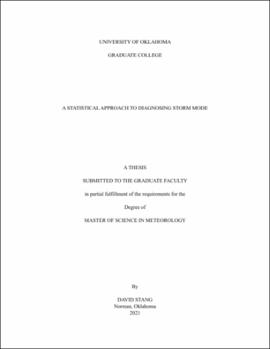| dc.contributor.advisor | Brooks, Harold | |
| dc.contributor.author | Stang, David | |
| dc.date.accessioned | 2021-12-13T15:04:03Z | |
| dc.date.available | 2021-12-13T15:04:03Z | |
| dc.date.issued | 2021-12-17 | |
| dc.identifier.uri | https://hdl.handle.net/11244/332302 | |
| dc.description.abstract | Determining storm mode (linear or isolated) is a crucial component of any severe weather forecast. Isolated storms are associated with a greater likelihood of significant (EF2+) tornadoes and very large (2”+) hail, while linear storms are more likely to produce straight-line wind damage. Current operational convection allowing models (CAMs), which are often used to diagnose storm mode, only run up to 48-60 hours into the future and can quickly lose accuracy with increasing lead time. To improve forecast accuracy and messaging on Day 3+ outlooks, a forecast tool was created to predict storm mode using only synoptic-scale variables. The approach uses a blend of theoretical modeling, stochastic modeling, and statistical modeling. The formulation generally performed well with reproducing past events and predicting future events 84+ hours in advance using 0.5° Global Forecasting System (GFS) and 0.5° Global Ensemble Forecasting System (GEFS) outputs. | en_US |
| dc.language | en_US | en_US |
| dc.subject | storm mode | en_US |
| dc.subject | severe weather | en_US |
| dc.subject | forecast | en_US |
| dc.subject | prediction | en_US |
| dc.title | A Statistical Approach to Diagnosing Storm Mode | en_US |
| dc.contributor.committeeMember | Richman, Michael | |
| dc.contributor.committeeMember | Wang, Xuguang | |
| dc.date.manuscript | 2021-12-10 | |
| dc.thesis.degree | Master of Science in Meteorology | en_US |
| ou.group | College of Atmospheric and Geographic Sciences::School of Meteorology | en_US |
| shareok.nativefileaccess | restricted | en_US |
